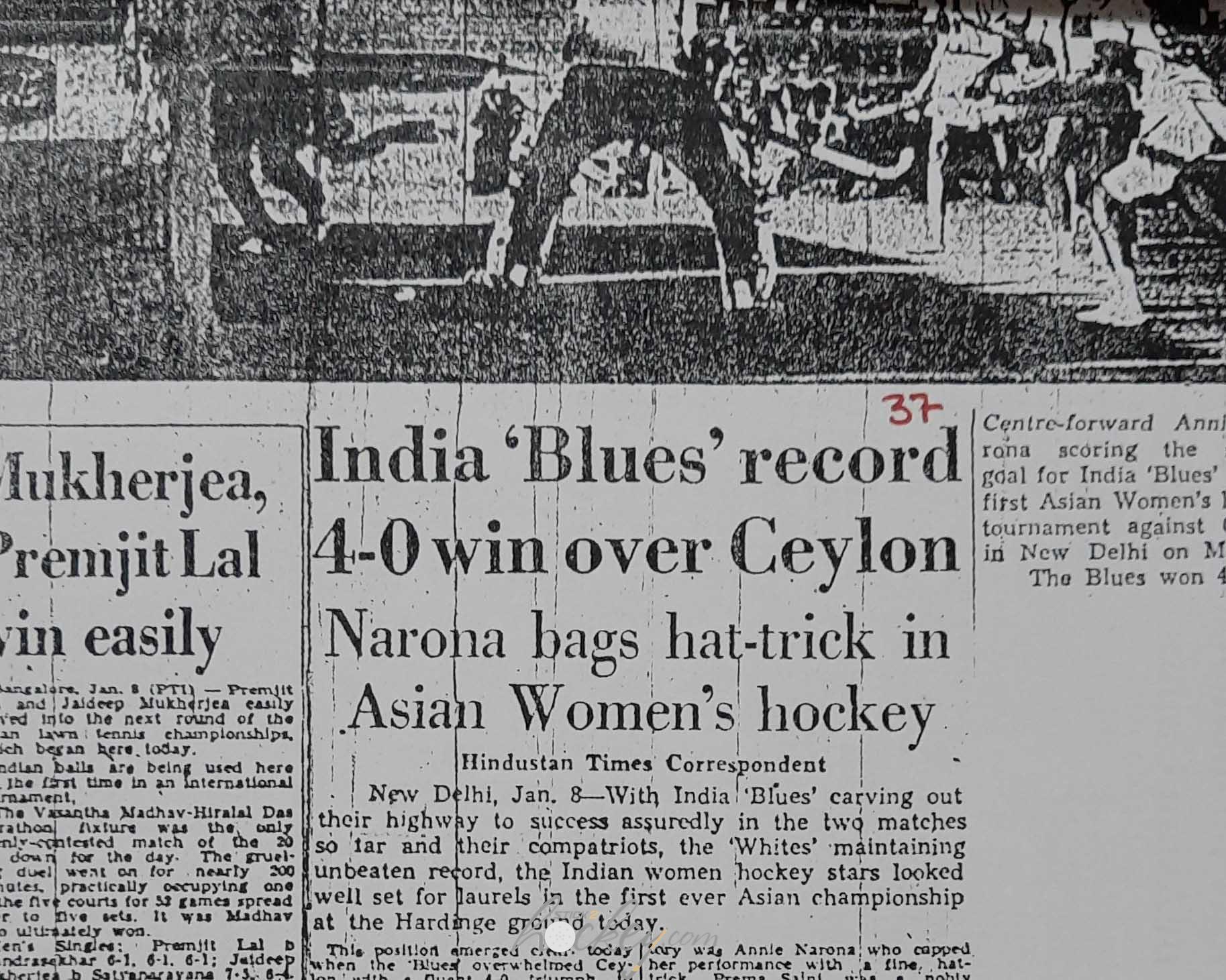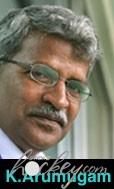When India organized Asia’s first-ever women’s hockey international, Africa came down to rescue it
When India organized Asia’s first-ever women’s hockey international, Africa came down to rescue it
Share
K. ARUMUGAM
On the eve of India hosting an Asian Hockey Federation’s flagship event — the Jharkhand Asian Champions Trophy — its worthwhile to recollect India’s role in pioneering women’s hockey in Asia and Africa and also being the first nation to host an invitation tournament in Asia.
India mooted and put in place the Asian Women’s Hockey Federation (AWHF) in the 60s, and it was fitting that India’s ace politician and parliamentarian Begum Aizal Rasool headed it for a couple of decades.
India, Japan, Sri Lanka are the early birds insofar as taking women’s hockey seriously and engaging their teams in bilateral series.
After two failed attempts (deli and Kolkata) that took place in the gap of 10 years, Indian women put up their first National Championship way back in 1946 in then Mumbai.
Indian women’s hockey achieved a memorable milestone when they organised the first Asian Women’s Hockey Championship in Delhi in 1968. Originally, ten Asian countries accepted the invitation of the All India Women Hockey Association. However, Singapore, Malaysia and Korea withdrew in the last minute.
So the Indians thought with vision of course to transcend to another continent to fill up the vacuum. This had a far reaching positive impact, as these continents would forge a long lasting hockey relationship forever.
Two African countries Uganda and Kenya agreed to come to India ‘invitees’ for the 1968 tournament, while India fielded two teams, ‘Whites’ (Captain Avinash Sidhu) and ‘Blues’ led by Annie Sampson.
Some critics questioned the wisdom of two teams from one country; ‘Can India field two teams in the Olympics’, a writer asked in his weekly column.
These criticisms paled against another controversy that raged in the run up. That pertained to the boycott of strong Mysore State players. It included superstar of the days Elvira Britto and her famed sisters. They abstained. Elvira was the most experienced of players and had successfully captained India sides against Sri Lanka, Japan and Australia, in the immediate past. She was also decorated with the Arjuna award. Elvira faced disciplinary actions later, but she and her State, Mysore, fellows stuck to their ground and shunned the Delhi gala.

Extensive coverage of the first Asian Cup for Women held in India in 1968
Elaborate arrangements were made for the much talked about tournament. Befitting the grand occasion, gates were not free. The rate of admissions were Rs.10, Rs.5, Rs.3 and Rs.1. All Rs.2 tickets were reserved for students, which were sold strictly in college campuses only.
Vice-President of India, VV Giri, inaugurated the gala event after an impressive march past. Both Indian teams ended third and fourth position in the points table. Uganda which won all its three matches topped the chart followed by Japan. India Blues and Japan had same points (4) but the later had plus 4 goal difference compared to plus 2 of India.
Air Delhi broadcast running commentary in English and Hindi on Delhi 98 and Delhi A from 3.40 PM onwards. Sarandindu Sanyal and Vijay Kaura were the commentators in English. Sushil Jain and Kumar Dixit did the same for Hindi audience.
These stalwarts had much to comment in the Air, as the tournament would produce big news every day. There was even a scuffle on the field of play, perhaps never seen in women hockey at least. A match report on India Whites and Uganda — that appeared in a leading English daily next day — captured this particular event frame by frame under the caption, ‘Frayed tempers, ugly incidents mar play’. It involved Indian player Neela Naidu and Uganda’s inside-left Zulema D’Souza. The details are graphically described in my book ‘Glimpses of Indian women’s hockey’, published in 2012.
It is interesting to note here about Zulema. She was one of the five Indian Goan migrants in the Uganda team.
However, both Indian teams lost the semifinals, dominating Whites to an extra time goal, and the Blues, which was a senior Indian side to an early second half goal, leading to the host teams playing for the consolation bronze. This match ended in a 1-1 draw and the teams were declared joint winners. Thankfully, Japan defeated Uganda in the final. Japan’s centre-half Terada struck the only goal of the Saturday final off a penalty corner in the 10th minute. Otherwise history would have witnessed a strange situation – An African country crowned as Asian Champion!
The much-popular Championship did not end with Japan annexing the title. Two exciting Exhibition matches were played: Asian XI Vs African XI followed by Dhyan Chand Veterans Vs Champions XI.
Over all the hefty grant of Rs.40,000 given by the Union Sports Ministry to underwrite the expenses was worth in gold as it gave India the honour of hosting the first ever international tournament for women.
If Asia today is a force to reckon with in the contemporary World’s women hockey, what with Korea and China winning Olympic and World Cup medals, the early contribution of India needs no over emphasis.
The finalist of the Championships played a series of Exhibition matches in Northern part of India to a large crowd, bringing in their wake the vibrancy of women hockey to the fore. The Ministry sanctioned the grant aiming to popularise women hockey, the objective was well and truly achieved.
The Indian Hockey Federation hosted Asia’s first ever 12-Nation Cup in Ahmadabad, Gujarat, in 1962. Six years later, our women earned the same ‘historical first’ tag with the organization of the Asian Champions Cup.
India organized so may bilateral series, invitation tournaments, AHF and FIH’s events subsequently, but the New Delhi event in 1968 paved way everything else.
Source: 1. Hockey Years Books 2. Glimpses of Indian women’s hockey book. Both authored by this writer.
www.stick2hockey.com is India’s oldest hockey website. Launched in 1999, the website, edited and owned by hockey historian and author K. ARUMUGAM, has covered all
major tournaments and events with precision. www.stick2hockey.com is the first site in the hockey world to bring viewers live text commentary and duly entered the prestigious Limca Book of Records. If vintage stories are what you are looking for, this site is the right one for you. You will also find pictures, some of them among the rarest, images of precious newspaper clippings, match reports, news breaks, interviews, features, statistics and history on a site respected by one and all in the hockey world.

 major tournaments and events with precision. www.stick2hockey.com is the first site in the hockey world to bring viewers live text commentary and duly entered the prestigious Limca Book of Records. If vintage stories are what you are looking for, this site is the right one for you. You will also find pictures, some of them among the rarest, images of precious newspaper clippings, match reports, news breaks, interviews, features, statistics and history on a site respected by one and all in the hockey world.
major tournaments and events with precision. www.stick2hockey.com is the first site in the hockey world to bring viewers live text commentary and duly entered the prestigious Limca Book of Records. If vintage stories are what you are looking for, this site is the right one for you. You will also find pictures, some of them among the rarest, images of precious newspaper clippings, match reports, news breaks, interviews, features, statistics and history on a site respected by one and all in the hockey world.
